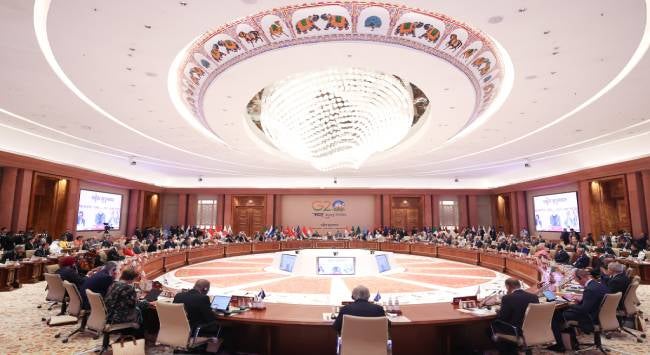Summary
India’s G20 presidency, which concluded with its highly consequential summit, sets the tone for future G20 economic cooperation without being consumed by geopolitical tensions.
Leading up to the concluded G20 summit in New Delhi, discussions focused on the absence of Chinese President Xi Jinping and Russian leader Vladimir Putin and whether their absence would cast a spectre on proceedings and a declaration. It did not. The Indian government and diplomats deftly handled the divisions between the major powers to hammer out a declaration that prioritised global economic concerns and the need to tackle them head-on inclusively while paying lip service to the Ukraine war. The successful declaration, though light on binding commitments and pledges, proved that India has arrived as a bridging power – working between the east and west and north-south – to help address global challenges while being savvy of the geopolitical implications.
India’s G20 summit was particularly notable for inclusion. As the voice of the Global South, India shepherded the addition of the African Union (AU) as a permanent member to the forum. The AU, with 1.4 billion people, finds a seat alongside the European Union (EU) as a regional organisation in the G20. Until now, only South Africa, as a permanent member, could participate in the G20 as an African country. With the recent BRICS (Brazil, Russia, India, China and South Africa) expansion and now the G20, African countries are receiving their multilateral due and representation. The AU’s inclusion will also mean the G20 will likely focus more on development issues like debt relief, climate finance, health equity and reforms of international financial institutions.
Considerable efforts went to prioritise reforms of multilateral development banks like the World Bank. In the declaration, the G20 prioritised reforms in these banks to add climate financing to their core mission though without stipulated capital increases. Multilateral development banks were also asked to support and execute the Common Framework for Debt Treatment to ensure low-income countries receive adequate debt relief support as they grow their economies. The G20 resolution on multilateral development banks reform arrives when several debt-laden developing countries deal with various economic challenges, including high inflation and interest rates, and require better terms for dealing with debt instead of turning to alternate more coercive options. These banks were pushed to provide additional financing to developing countries that could then help mobilise private capital.
The summit’s two biggest outcomes were the launches of the India-Middle East-Europe Economic Corridor (IMEEC), an ambitious connectivity initiative built through railways and ports, and the Global Biofuels Alliance. The IMEEC, a joint venture between Saudi Arabia, the EU, India, the United Arab Emirates, France, Germany, Italy and the United States, hopes to capitalise on the need for greater connectivity and supply chain operations across the Eurasian landmass. The initiative could potentially cut shipping times while turbocharging trade flows through the Middle East. The founding members have also discussed installing cables for electricity and data and a hydrogen pipeline for energy flows. The initiative also stands as a challenge and rejoinder to China’s Belt and Road Initiative, a similarly designed initiative to expand Chinese infrastructural influence. Though the Delhi Declaration was light on climate commitments, it did launch the Global Biofuels Alliance as a signature clean energy transition initiative that seeks to deploy cleaner energy fuels to support decarbonisation.
Biofuels aside, the Delhi Declaration was light on climate change commitments. Experts lauded efforts to get more climate financing to countries as well as the push given to renewables but criticised the lingering focus on oil and gas instead of figuring out ways to wean the world away from those energy sources. The declaration did not cover the phasing down of fossil fuels to achieve net-zero carbon emissions. In terms of the energy transition, the G20 countries pledged to pursue efforts to scale up renewable energy to reduce necessary emissions by 2030 to “contain global warming below devastating levels”. Climate finance, however, received considerable attention as low-income economies struggle with insufficient financial support to engineer their climate transitions without harming their economic prospects. The G20 text calls for the developed countries to fulfil their existing climate finance commitments that amount to US$100 billion (S$1.36 billion) annually and to increase pledges for climate adaptation. Developing countries will require US$6 trillion (S$8.16 trillion) by 2030 to achieve domestic climate targets and around US$4 trillion (S$5.4 trillion) annually by 2030 for adaptation.
Without Xi and Putin, the 2023 G20 summit represents a diplomatic triumph for Indian Prime Minister Narendra Modi and India. The Delhi Declaration delivered almost everything they wanted, despite misgivings on the language covering critical issues like Ukraine and climate change. The declaration was a breakthrough, given acute divisions over Ukraine while dealing with Russian and Chinese interests. Perhaps Xi and Putin’s absence allowed Indian diplomats to seize the most amenable path forward on Ukraine while going strong on prioritising the Global South and its economic challenges and how they can be addressed. Inclusion and economic justice were big themes that should sustain next year’s G20 agenda under Brazil’s presidency. The focus on climate financing and connectivity was prominent and long overdue. New Delhi has placed the Global South at the heart of the G20, possibly the most lasting legacy of this summit and India’s presidency.
. . . . .
Dr Karthik Nachiappan is a Research Fellow at the Institute of South Asian Studies (ISAS), an autonomous research institute at the National University of Singapore (NUS). He can be contacted at isaskn@nus.edu.sg. The author bears full responsibility for the facts cited and opinions expressed in this paper.
Pic Credit: Narendra Modi’s Twitter Account
-
 More From :
More From :
-
 Tags :
Tags :
-
 Download PDF
Download PDF



